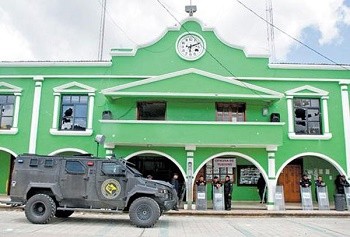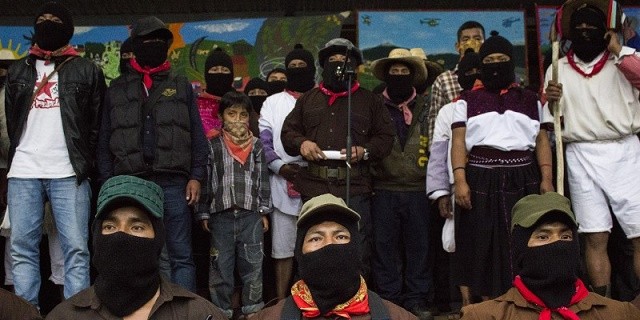Filed under: Editorials, Indigenous, Labor, Repression, Southern Mexico
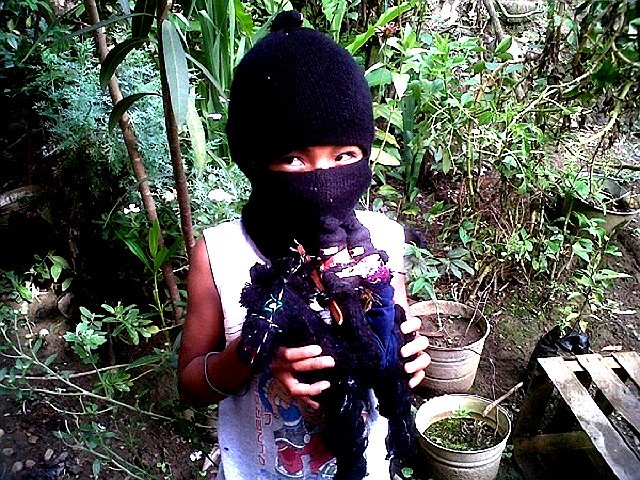
Here is a really bad photo I took today of zapatistas dancing to ska. Other highlights:
Hip-hop and poetry pic.twitter.com/cak9WFggAt— ((counterapparatus)) (@walmas) July 30, 2016
From Dorset Chiapas Solidarity
A. Zapatista News And CompArte Festival
“For us Zapatistas, the arts are the hope of humanity…. And in the most difficult moments, when disillusionment and impotence are at a peak, the Arts are the only thing capable of celebrating humanity.”
“If the machine imposes a perverse logic in which every tragedy numbs rather than enrages, perhaps it could be the Arts that remind humanity that people not only kill and destroy, impose and dominate, humiliate and doom to oblivion, but can also create, liberate, and remember.”
On 4th July, a communiqué entitled “Lessons from June” is released, signed by Subcomandantes Moisés and Galeano and with a note from the Cat-Dog. The EZLN reiterate their support for the teachers’ struggle, and thank the teachers in rebellion and the people who support them for the free public seminar in resistance they have given during the month of June, which has resulted in more and more people joining their fight. It is necessary to concentrate all energies on this struggle. “This is the time of the teachers in resistance. It is necessary and urgent to be with them.”
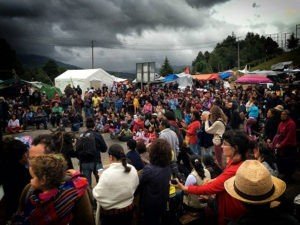 Therefore, they say, the EZLN has reached a difficult decision: they have decided to “suspend our participation in the CompArte festival, in Oventic as well as in CIDECI ….” and to “donate all of the money and food we have saved for our transportation to and from Oventic and CIDECI and for provisions while we are there to the teachers in resistance.” They report that 1,127 artists from every corner of Mexico, and 318 artists from other countries have registered for the festival, and ask for their understanding.
Therefore, they say, the EZLN has reached a difficult decision: they have decided to “suspend our participation in the CompArte festival, in Oventic as well as in CIDECI ….” and to “donate all of the money and food we have saved for our transportation to and from Oventic and CIDECI and for provisions while we are there to the teachers in resistance.” They report that 1,127 artists from every corner of Mexico, and 318 artists from other countries have registered for the festival, and ask for their understanding.
This message is interpreted by some of the registered participants as saying that the entire festival has been cancelled, so another communiqué, “the CompArte Festival And Solidarity,” follows two days later, to clarify: “We didn’t say that the festival itself was suspended. We merely indicated that we as Zapatistas would not be able to contribute.” A list follows of the states of Mexico and countries of the world that the artists registered to participate come from, and all the different artistic activities to be shared.
The Zapatistas also “want to let you know what our artistic contribution was going to be like,” and include a video of a choreographed dance called Resistance. From the 5 caracoles, 1,819 artists and 1,566 listener-observers were due to participate, a total of 3,385 men, women, children, and elders, Zapatista bases of support.
The total cost of food and supplies put together for this participation came to 290,000 Mexican pesos (approximately £11,700.) “The money came from the work of the production collectives across the communities, regions, and zones, as well as from the MAREZ [Zapatista Autonomous Municipalities in Rebellion] and the Good Government Councils.” Each caracol has gathered together supplies equivalent to what they would have used, and delivers this as material support to the teachers in resistance on the 8th, 9th and 10th July, in a wonderfully symbolic act of solidarity.
“Chiapas is beautiful. And now even more so with the teachers’ resistance flourishing in the streets, roads, highways, and communities.”
Their question “Should CompArte happen? That question is for all of you,” is answered very quickly, as the compas from CIDECI-Unitierra announce that “the CompArte Festival is on.” “We want to inform you that we are continuing preparations to celebrate this sharing-exchange from July 23 through July 30. Our CIDECI-Unitierra community will keep its doors open to receive all of the persons, communities, and collectives that have felt in their hearts this call to come share experiences of art, struggle, and resistance.”
The Subcomandantes respond on 13th July with “For La Maestra, With Affection”. They include “two videos dedicated to women below and to the left, and especially to the maestras in struggle.” These are both choreographed dances, “the Dance of the Rights of Women,” and “Las Musiqueras.”
A second communiqué follows on the 17th: “The Geography? Oventik. The Calendar? July 29, 2016,” inviting everyone to come to Oventic on 29th July to participate in a condensed presentation of the artistic works the Zapatistas had prepared for the festival, as a mark of admiration and respect for all the artists who have committed to participating in CompArte.
“We want them to know of our conviction that in the dark hours of the present and the dark hours to come, their work and creativity will be required to find the path that we, humanity as a whole, want, need, and deserve…. We as Zapatistas think that it is wonderful that there are artists who know how to bring forth, from the depths of the darkest calendar, a light for humanity.”
The first welcoming ceremony to the CompArte festival takes place on 19th July with an event at the camp and roadblock of the people and the teachers which had been blocking the exit to the highway to Tuxtla Gutierrez in San Cristobal de Las Casas for over a month. Local artists and spectators arrive, both from Mexico and other parts of the world. 19 pieces of poetry, music, acrobatics and theatre are presented as well as two projections of indigenous resistance, in the Cauca (Colombia) and the Kurdish revolution. On the 20th the camp is violently attacked and evicted, but participants regroup and it is restored.
On 21st July, the EZLN, in the names of Subcomandante Insurgente Moisés and Subcomandante Insurgente Galeano, publish an “Open Letter On The Aggressions Against The People’s Movement In San Cristóbal De Las Casas, Chiapas,” addressed to the governor of Chiapas, following this attack on the people’s resistance encampment. The attackers were masked in an attempt to identify them as Zapatistas, but as the letter points out, the locals knew otherwise. “If you destroy their camps they’ll build them back up. Time and time again.”
The main festival gets underway on the 23rd July at the Indigenous Centre for Integral Training-University of the Earth, Chiapas (CIDECI-Unitierra), based in San Cristobal de Las Casas, offering a wide variety of artistic performances, with more people attending every day.
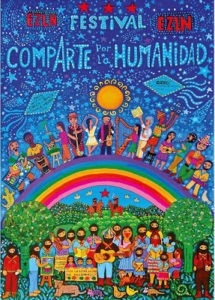 On 26th July, “the EZLN Confirms And Extends Its Participation In CompArte” is released. This communiqué confirms the invitation to Oventic for 29th July, with performances from indigenous artists from Los Altos, and adds that a Zapatista delegation will attend CompArte on 30th July at Cideci as listener-viewers. In addition, performances by Zapatista artists will take place at the other Zapatista caracoles as follows: La Realidad, 3rd August, La Garrucha, 6th August, Morelia, 9th August, including celebration of the 13th anniversary of the birth of the Zapatista caracoles and the Juntas de Buen Gobierno, and finally, Roberto Barrios, on 12th August.
On 26th July, “the EZLN Confirms And Extends Its Participation In CompArte” is released. This communiqué confirms the invitation to Oventic for 29th July, with performances from indigenous artists from Los Altos, and adds that a Zapatista delegation will attend CompArte on 30th July at Cideci as listener-viewers. In addition, performances by Zapatista artists will take place at the other Zapatista caracoles as follows: La Realidad, 3rd August, La Garrucha, 6th August, Morelia, 9th August, including celebration of the 13th anniversary of the birth of the Zapatista caracoles and the Juntas de Buen Gobierno, and finally, Roberto Barrios, on 12th August.
On 29th July, CompArte moves to Oventic for the day, where the Zapatistas share their struggle and creative resistance through many forms of music, dance, theatre, painting and poetry. The dancing is often to live music, which varies from ska and hip-hop to rancheros and corridos. There is a photo-essay of the event in Spanish here.
Subcomandante Insurgente Moisés gives the opening and closing words. At the inauguration his words are full of power and emotion. The Zapatistas are deeply hurt by the paid media who have misrepresented the recent events in Chamula.
“We know perfectly that the paid media says that in Chamula the municipal president from the Verde Ecologista (PVEM) was killed. Because this is the party of the overseer Velasco the paid media are there crying and lamenting what happened, but they say nothing of the rest of the dead. They say nothing of those who later died in their homes or of those whose dead or dying bodies were taken away by their families. For the government and the press those deaths don’t matter. There were actually dozens of dead, not just five corrupt officials.”
His speech reinforces the theme, seen in many of the performances and works of art, of the long history of oppression and resistance, from the time of colonisation to the present day. He speaks of the lack of justice for indigenous people throughout history.
“Better for us to organize ourselves to build a new house, that is a new society. No one is going to fight for us. Just like for us Zapatistas, no one came here and struggled for us. In other words, we had to give our lives because we want more than just our lives.”
In his closing speech, Moisés invites all attendees to go to the rest of the caracoles over the coming days to enjoy the work of “thousands of artists.” His message focuses on talking about the meaning of art for the Zapatistas, the art of solidarity and the art of organization to make that solidarity possible.
B. Other events in Chiapas
July 2016 is a very intense month in Chiapas, and this news summary can only give an overview of some of what took place, and provide more detail of important happenings already mentioned.
1. Increasing indigenous and popular support for teachers’ struggle: It is clear that, especially in the south of Mexico, a region with a high indigenous population and levels of poverty, the teachers’ struggle against the education reform has become a peoples’ struggle against all the neoliberal reforms. As well as support from the Zapatistas, more and more groups in Chiapas, such as Las Abejas, Xi’Nich, Pudee, Banavil, Bachajόn and Semilla Digna, are making pronouncements, thus broadening and strengthening the struggle.
2. Pueblo Creyente continue their series of pilgrimages: On 1st July people from more than 15 parishes from the south-eastern region of the diocese of San Cristobal de Las Casas march on their third pilgrimage in Tuxtla Gutierrez to show their support for the teachers’ movement. Then, on July 18, about 30,000 members of the Pueblo Creyente, representing 52 parishes from throughout the state, hold a pilgrimage together with thousands of teachers in Tuxtla Gutierrez demanding that the government discuss in “public dialogue” not only the education reform, but also the so-called structural reforms that they have been promoting. They also deliver food supplies to the teachers in Tuxtla. At this huge march concerns are expressed that the federal government might negotiate and then betray its word, as it already did with the EZLN after the agreements from the dialogues in San Andrés in 1996.
3. Ejido san Sebastian Bachajón supports teachers: On 4th July members of the ejido San Sebastian Bachajón, adherents to the Sixth Declaration, issue a communiqué in support of the teachers. A second communiqué on 21st July reports that they have just delivered material supplies to the teachers in resistance after a drive of more than six hours.
4. Attack on the encampment and blockade on the road between San Cristobal de Las Casas and Tuxtla Gutierrez: This roadblock has grown and become organised as a popular assembly, gathering up to 3,500 demonstrators at any one time, including teachers and parents from impoverished neighbourhoods, medical students, indigenous associations and grassroots movements. It is the only roadblock that remains, by decision of the assembly, after the others are dismantled.
A violent attack occurs on this roadblock and encampment/occupation on 20th July, when, accompanied by state and municipal police, armed and masked members of the Green Party (PVEM) from the indigenous municipality of San Juan Chamula are driven to the blockade, where the police provide cover and watch while the paramilitaries attack and burn the tarpaulins and tents of the encampment, setting them on fire and destroying them with machetes. According to La Jornada, the attack is perpetrated by several dozen people who are officials of San Juan Chamula, and also involves over a hundred indigenous men from San Cristóbal, led by their mayor. The men from Chamula are led by the mayor of San Juan Chamula, Domingo López González. There are no deaths, though one teacher is shot in the shoulder by a paramilitary, and another participant is run over. The total number of injured has not been released, and there are also attacks on the press.
In response, teachers and supporters regroup in the city centre of San Cristóbal, taking over the old city hall They then march back to the site of the roadblock and build it up once again. The restored blockade consists of several hundred people. It remains until 29th July, when it is taken down.
Several communities in the municipality of Chamula release a statement condemning the attack and expressing their support for the teachers. Tellingly, The Zapatistas issue a warning in their 21st July communiqué: “And some unsolicited advice: don’t play with fire in Chamula. The unrest and division you are inciting in that town with your stupidities could provoke an internal conflict of such terror and destruction that you wouldn’t be able to quash it with social network bots or paid “news” articles or the little money Manuel…Velasco… has left in the state treasury.”
5. Massacre in San Juan Chamula:
San Juan Chamula is a very large Tsotsil municipality near to San Cristóbal, frequently visited by tourists who go mainly to view its famous traditional customs. It forms a group of communities deeply divided by religion, by political party affiliation, by local power factions and as a result of the tourist income and of visits by evangelical missionary organisations over many years. A group of Green Party (PVEM) supporters from Chamula, described as “paramilitaries” and led by the mayor, were among those who attacked the teachers’ blockade on 20th July.
On 23rd July, a group of individuals affiliated with the PRI go to the town hall demanding that the mayor, who as previously stated is affiliated with the PVEM, pay them the money he owed them which had been given for public works and for their craft work, and which had been withheld from them. The mayor refused to do so at that time and the PVEM supporters, along with the mayor and his bodyguards, opened fire on the people in the town square; a very long shoot-out commenced in the centre of the town. In the end, “dozens of people” are killed, although only five of these are named, including the mayor and another town hall worker. The total number of dead has not been revealed as families claimed the bodies and took them away privately. Some estimates suggest as many as twenty were killed by gunfire and machete. There were also a substantial number of injured. Subcomandante Moisés at Oventic is scathing about the coverage of the massacre by the ‘paid media’: “for the government and journalists these deaths don’t matter.”
The Zapatistas and alternative media sources hold Manuel Velasco Coello, governor of Chiapas, responsible for these events, blaming his administration for encouraging and fomenting conflicts. The governor recently declared in a campaign event that whichever party won Chamula would win the governorship of Chiapas.
In the words of Subcomandante Moisés at Oventic: “We do not care if they are not Zapatistas in the village of Chamula. They are our brothers. They are indigenous and those who were killed in the village of San Juan Chamula are part of our indigenous people, of our original race.”
The mayor of Chamula, Domingo López González, used to campaign with the PRI, but was elected as a candidate for the PVEM last year. Chamula had been PRI-controlled for 80 years until López González assumed office as mayor for the PVEM in October 2015. There have been an increasing number of clashes between supporters of political parties, primarily the PRI and the PVEM, in Chiapas communities this year. For example, another conflict between the PRI and PVEM led to the deaths of two people and the displacement of 81 in ejido or colonia Puebla, Chenalhó, on 26th May. It is easy for political parties to manipulate and foster internal divisions, and this has been one of the factors leading to indigenous communities organising to construct their own autonomy, banning political parties and returning to making decisions using their own community assemblies, according to customary practices, and following the Zapatista example.
C. The Teachers’ Strike:
This small monthly summary of the Zapatista/Chiapas news cannot attempt to encompass all the struggles underway in Mexico at the moment, merely to provide some indicators which can be followed up further.
The teachers have now been on strike for 2.5 months. Since the massacre in Nochixtlan, Oaxaca, on June 19th, there has been an increase in direct actions, marches, material support and expressions of solidarity.
As examples of this, Section 22 of the CNTE in Oaxaca calls for a gathering of teachers and indigenous leaders to “build a peoples’ agenda against structural reforms,” based on discussions and agreements reached in community assemblies, and an Indigenous Peoples Caravan travels from Oaxaca to Mexico City from 17th to 19th July.
Meanwhile CNTE leaders hold ongoing talks with the government, so far without progress. Government officials have shown no willingness to negotiate the reforms which have so far led to the dismissal of nearly 10,000 people.
On the subject of the Zapatistas, readers may be interested in this article, re-printed from Counterpunch.
It should be noted that at the time of publication of this news summary, the closing words of Subcomandante Moises in Oventic were not available in any language.



